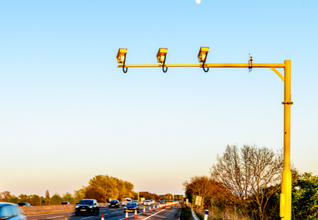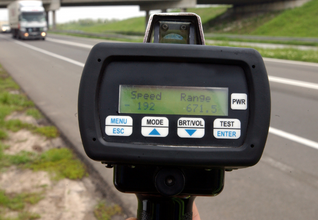Driving on Irish roads can be an exciting experience with stunning landscapes and unique terrain. However, speeding remains one of the leading causes of accidents on Irish roads, posing a significant risk to drivers, passengers, and other road users.
To tackle this issue, the Irish government has implemented various speed management measures, including testing average speed cameras. These cameras have become increasingly common in Europe. While some drivers may feel frustrated or inconvenienced by them, their use has been proven to reduce speeding and improve road safety.
This post will explore average speed cameras in Ireland, how they work, and their impact on road safety.
What’s an Average Speed Camera?
You may have heard about average speed cameras but are unsure what it is. In Ireland, we now use fixed-speed cameras which capture a vehicle’s speed at a fixed point on the road. The difference with average speed cameras is that they track a vehicle’s speed over a set distance.
Where Will You Find Average Speed Cameras in Ireland
In recent years, Ireland has expanded its use of average speed cameras to both improve road safety and reduce incidents of speeding. Cameras are usually placed in areas with high rates of speeding or accidents. Average speed cameras can be found at Port Tunnel in Dublin and along the the M7.
Average speed cameras are installed on the M7 and monitor a driver’s average speed driving between Junction 26 and Junction 27, which is a 9km stretch. You will be penalised if you go above the motorway speed limit of 120km/h.
As of October 2024, two new average speed camera systems became operational:
- N3 in County Cavan: Between Kilduff and Billis.
- N5 in County Mayo: Between Lislackagh and Cuilmore, Swinford.
In addition to these, An Garda Síochána announced locations for nine static speed safety cameras which have been proven internationally to reduce speeding.
The cameras, which were funded by An Garda at a cost of approx. €2.4 million, were placed in areas where serious and fatal collisions occur and were selected based 7-years of collision and speed data.
The locations for the nine static speed safety cameras are:
- N59 in County Galway: Between Moycullen and Galway City.
- N25 in County Waterford: Between Glenmore and Luffany.
- R772 in County Wicklow: Arklow Road, Aske, north of Gorey.
- N14 in County Donegal: East of Letterkenny.
- N80 in County Carlow: Between Barristown and Levitstown.
- Dublin: Crumlin Road/Parnell Road/Dolphin Road/Dolphin’s Barn Junction.
- N17 in County Mayo: Northeast of Claremorris.
- N22 in County Cork: East of Lissarda, west of Ovens.
- N69 in County Limerick: East of Askeaton.
How do Average Speed Cameras Work?

They use Automatic Number Plate Recognition (ANPR) technology to read the number plate of every vehicle which passes the camera’s field of view. It then creates a time, date and location file for every vehicle. When a vehicle reaches the next camera too quickly, the number plate will be flagged that a violation has occurred. They are then processed back in an office.
It is challenging to “trick” an average-speed camera. They are seen as an effective tool for reducing journey time as there’s no disruption of traffic flow.
The installation of average speed cameras has decreased travel times due to a more disciplined traffic flow. The positive sides of this are that it will reduce fuel burned and decrease noise pollution along the roads that they are installed. There is currently no word on any more prospective sites for the cameras.
What Happens If You Are Caught Speeding By An Average Speed Camera
If you are caught speeding by an average speed camera—meaning your average speed exceeds the posted limit—you will face a fine of €160 and receive three penalty points on your driving licence.
You have 56 days from the issue date to pay the fine before further legal action is taken. The initial 28-day period allows you to pay the standard fine of €160. If you fail to pay this, you will have an additional 28 days to pay an increased fine of €240 (a 50% increase). After this period, you will receive a court summons with the option to settle the matter by paying an increased fine of €320 before the court date.
Reaction to Average Speed Cameras in Ireland
When first introduced, many drivers criticised them as they feel they are monitoring citizens too closely. They think there should be steps to prevent speeding rather than punish people for it. It is hoped that these average-speed cameras will change drivers’ behaviour on the road.
After a pilot year of the average speed cameras, compliance with the speed limit increased from 70% to just shy of 90%, which shows it has affected drivers’ behaviour toward the speed limit.
The average speed cameras are already in use on the Dublin Port Tunnel. They were highly effective in the tunnel, where only less than 1% of drivers exceeded the speed limit, down from 55% before installation, which shows a dramatic drop.
Other Speed Cameras
There are a variety of speed cameras used by law enforcement to clamp down on speeding. They include the following:
TruCAM II laser guns

These are the laser guns you will see Gardaí using when they are parked on the side of the road. They can see speeding cars from a distance of up to 1.2km away. The upside of these cameras is that they can spot a speeding driver before the driver can even see the Garda making it hard to avoid if you’re speeding.
Puma speed detection equipment
The benefit of Puma speed detection vehicles is that they cannot only see if you’re speeding, but they can also detect uninsured or untaxed drivers and other motor offences such as using a phone.
The equipment used by Gardaí is connected to a real-time database which provides information on vehicles, such as insurance, tax or if it’s stolen. It takes, on average, 6 seconds to scan a license plate.
Don’t Speed
We always recommend drivers stick to the speed limit of every road they drive on. If you speed, you risk the chance of getting in an accident, and it could prove fatal to an innocent car, pedestrian or cyclist. These speed cameras are here to save lives.
If you are caught speeding, you will get penalty points, and your insurance premium may increase as you are now at a higher risk of getting in an accident than someone without penalty points.
Looking to Save On Your Car Insurance?
At KennCo, our car insurance cover offers competitive rates and valuable benefits, including a replacement car as standard. Get peace of mind knowing you’re fully covered.
Get a Secure Quote Today
